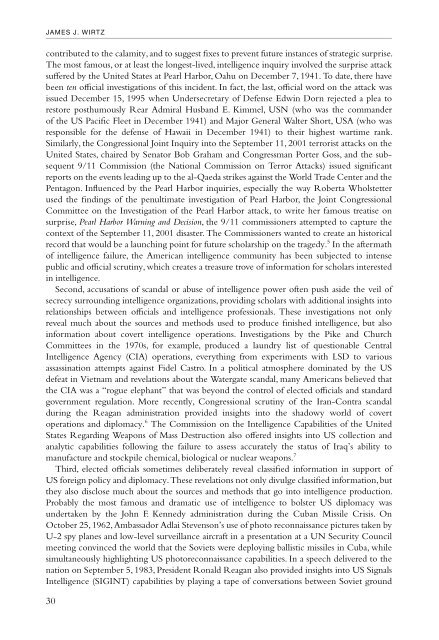Handbook of intelligence studies / edited by
Handbook of intelligence studies / edited by
Handbook of intelligence studies / edited by
You also want an ePaper? Increase the reach of your titles
YUMPU automatically turns print PDFs into web optimized ePapers that Google loves.
JAMES J. WIRTZ<br />
contributed to the calamity, and to suggest fixes to prevent future instances <strong>of</strong> strategic surprise.<br />
The most famous, or at least the longest-lived, <strong>intelligence</strong> inquiry involved the surprise attack<br />
suffered <strong>by</strong> the United States at Pearl Harbor, Oahu on December 7, 1941. To date, there have<br />
been ten <strong>of</strong>ficial investigations <strong>of</strong> this incident. In fact, the last, <strong>of</strong>ficial word on the attack was<br />
issued December 15, 1995 when Undersecretary <strong>of</strong> Defense Edwin Dorn rejected a plea to<br />
restore posthumously Rear Admiral Husband E. Kimmel, USN (who was the commander<br />
<strong>of</strong> the US Pacific Fleet in December 1941) and Major General Walter Short, USA (who was<br />
responsible for the defense <strong>of</strong> Hawaii in December 1941) to their highest wartime rank.<br />
Similarly, the Congressional Joint Inquiry into the September 11, 2001 terrorist attacks on the<br />
United States, chaired <strong>by</strong> Senator Bob Graham and Congressman Porter Goss, and the subsequent<br />
9/11 Commission (the National Commission on Terror Attacks) issued significant<br />
reports on the events leading up to the al-Qaeda strikes against the World Trade Center and the<br />
Pentagon. Influenced <strong>by</strong> the Pearl Harbor inquiries, especially the way Roberta Wholstetter<br />
used the findings <strong>of</strong> the penultimate investigation <strong>of</strong> Pearl Harbor, the Joint Congressional<br />
Committee on the Investigation <strong>of</strong> the Pearl Harbor attack, to write her famous treatise on<br />
surprise, Pearl Harbor Warning and Decision, the 9/11 commissioners attempted to capture the<br />
context <strong>of</strong> the September 11, 2001 disaster. The Commissioners wanted to create an historical<br />
record that would be a launching point for future scholarship on the tragedy. 5 In the aftermath<br />
<strong>of</strong> <strong>intelligence</strong> failure, the American <strong>intelligence</strong> community has been subjected to intense<br />
public and <strong>of</strong>ficial scrutiny, which creates a treasure trove <strong>of</strong> information for scholars interested<br />
in <strong>intelligence</strong>.<br />
Second, accusations <strong>of</strong> scandal or abuse <strong>of</strong> <strong>intelligence</strong> power <strong>of</strong>ten push aside the veil <strong>of</strong><br />
secrecy surrounding <strong>intelligence</strong> organizations, providing scholars with additional insights into<br />
relationships between <strong>of</strong>ficials and <strong>intelligence</strong> pr<strong>of</strong>essionals. These investigations not only<br />
reveal much about the sources and methods used to produce finished <strong>intelligence</strong>, but also<br />
information about covert <strong>intelligence</strong> operations. Investigations <strong>by</strong> the Pike and Church<br />
Committees in the 1970s, for example, produced a laundry list <strong>of</strong> questionable Central<br />
Intelligence Agency (CIA) operations, everything from experiments with LSD to various<br />
assassination attempts against Fidel Castro. In a political atmosphere dominated <strong>by</strong> the US<br />
defeat in Vietnam and revelations about the Watergate scandal, many Americans believed that<br />
the CIA was a “rogue elephant” that was beyond the control <strong>of</strong> elected <strong>of</strong>ficials and standard<br />
government regulation. More recently, Congressional scrutiny <strong>of</strong> the Iran-Contra scandal<br />
during the Reagan administration provided insights into the shadowy world <strong>of</strong> covert<br />
operations and diplomacy. 6 The Commission on the Intelligence Capabilities <strong>of</strong> the United<br />
States Regarding Weapons <strong>of</strong> Mass Destruction also <strong>of</strong>fered insights into US collection and<br />
analytic capabilities following the failure to assess accurately the status <strong>of</strong> Iraq’s ability to<br />
manufacture and stockpile chemical, biological or nuclear weapons. 7<br />
Third, elected <strong>of</strong>ficials sometimes deliberately reveal classified information in support <strong>of</strong><br />
US foreign policy and diplomacy. These revelations not only divulge classified information, but<br />
they also disclose much about the sources and methods that go into <strong>intelligence</strong> production.<br />
Probably the most famous and dramatic use <strong>of</strong> <strong>intelligence</strong> to bolster US diplomacy was<br />
undertaken <strong>by</strong> the John F. Kennedy administration during the Cuban Missile Crisis. On<br />
October 25, 1962, Ambassador Adlai Stevenson’s use <strong>of</strong> photo reconnaissance pictures taken <strong>by</strong><br />
U-2 spy planes and low-level surveillance aircraft in a presentation at a UN Security Council<br />
meeting convinced the world that the Soviets were deploying ballistic missiles in Cuba, while<br />
simultaneously highlighting US photoreconnaissance capabilities. In a speech delivered to the<br />
nation on September 5, 1983, President Ronald Reagan also provided insights into US Signals<br />
Intelligence (SIGINT) capabilities <strong>by</strong> playing a tape <strong>of</strong> conversations between Soviet ground<br />
30
















